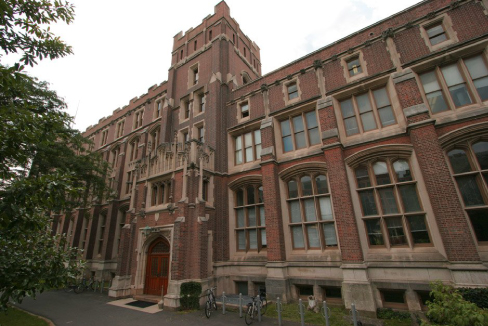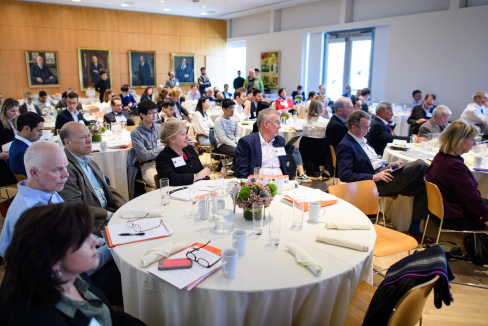Over its first decade, CMI has accomplished many of its original goals by creating tools to address critical questions about the efficacy and cost of carbon capture and storage and the impacts of climate change on natural carbon sinks.
Computer models have been developed or adapted to carry out groundbreaking simulations of novel energy systems, underground CO2 injection, carbon cycling between the atmosphere and biosphere, and the impacts of climate change. New instruments and data assimilation have bolstered a “carbon observing system” that tracks changes in the natural carbon cycle, and innovative analytical methods have yielded data that constrain the causes of ice ages. On the policy front, original conceptual tools have advanced the global discussion on carbon and climate by offering fresh perspectives on solutions.
As these tools continue to be refined and others are developed, we are entering a new phase in which models are applied to real-world scenarios, tools are being made available to the public, and strategies being sought to motivate near-term carbon mitigation projects.
As CMI’s research effort has grown and matured, its faculty and present and former students have also taken on important roles in the national conversation on carbon mitigation. CMI members have spoken in academic and policy forums, presented papers and posters at international meetings, taken part in numerous national and international studies, provided congressional testimony, hosted key meetings, and served on advisory boards for carbon and climate related projects.
Progress in our first decade
Each research effort within CMI has made important contributions to the field of carbon mitigation, through both academic research and influence in the wider community.
Carbon Capture
The Carbon Capture Group develops innovative strategies for producing low-carbon electricity and fuels. After separately analyzing co-production systems using fossil fuel and biomass as feedstocks, the group has found that hybrid systems that combine the economic advantages of coal or natural gas and the emissions-reducing potential of biomass with carbon capture and storage (CCS) offer deep reductions in carbon emissions and could be competitive at relatively low carbon prices.
Having established the capability to model a wide array of polygeneration systems using coal, biomass, and natural gas as inputs, the group has developed an Excel framework that allows experts to compare and contrast a wide range of alternative energy systems. Originally developed as part of the National Academies’ America’s Energy Future study, the framework continues to expand by treating additional configurations. The team has also contributed substantially to the IPCC’s Special report on Carbon Dioxide Capture and Storage and the latest Global Energy Assessment, and has helped develop legislation introduced in Congress to promote construction of coal energy projects that reduce emissions by 50%. The researchers have also been regular presenters at the International Conference on Greenhouse Gas Technologies (GHGT-10), the primary venue for presenting CCS research.
The Capture Group’s work to date has focused on the best low-carbon fuels and electricity producing options suitable for widespread deployment. In the near future, the team plans to concentrate on finding opportunities for low-cost deployment of first-of-a-kind plants, targeting facilities with already-concentrated CO2 streams and assessing the potential high value chemical co-products that could improve system economics.
The Capture Group has also included a program of “scouts” since its inception. Scouts are individual faculty members, generally based in Engineering, who shift a portion of their research into areas that directly contribute to CMI. Scouts have worked on the combustion of biomass, the longevity of batteries, and the improved integration of renewable energy technologies into the energy system, as well the equation of state for carbon dioxide in the presence of dilutants. Further participation of scouts is anticipated.
Carbon Storage
The Carbon Storage Group examines the challenges of storing CO2 in saline aquifers in regions where there has been oil and gas production, and the potential risk of leakage through existing wells. Because little was known about the interaction of CO2 and well cements, an experimental program was initiated early in the grant to study the durability of well cements under injection conditions. Those experiments have now been completed and are now being used to inform and verify simulations. In the field, a new technique to assess the effective permeability of existing wells was proposed by Princeton and has been used by bp at its own sites.
These experimental and field results are informing models developed to predict the fate of CO2 injected underground. A geomechanical model developed at Princeton, dynaflow, has been adapted to simulate aquifer geochemistry and multiphase flow as well as to predict physical stresses induced by CO2 injection. In parallel, simplified analytical and semi-analytical models have been created that allow rapid simulations of CO2 storage in regions with thousands of wells and enable probabilistic assessment of leakage risk.
The group has also had a wide impact in the CCS community, starting with hosting a major Workshop on Geological Storage of CO2 in 2005 that brought researchers from the U.S., Canada, and Europe together to discuss technical issues in the development of computational tools. Group members also contributed to the IPCC’s Special Report on Carbon Dioxide Capture and Storage, have served on advisory boards for the In Salah Project and the CO2 Capture Project, helped develop plans for a national facility for underground CO2 investigations, and have been regular presenters at GHGT conferences, presenting nine papers at the 2010 event alone. In addition, the researchers are working to disseminate their software through development of a public web interface and the formation of a new software startup company.
Moving ahead, Storage Group members are now applying their models to actual field sites, including the In Salah injection site in Algeria. In addition, a joint project with the capture group is analyzing the potential benefits of pressure control in injection fields through brine management, and work on risk assessment is ongoing. Finally, a recently initiated research program on the controls of gas hydrate stability is showing promising results and will also be continued.
Carbon Science
Since 2000, the Carbon Science Group, in partnership with collaborators at Princeton University’s neighboring institution, the Geophysical Fluid Dynamics Lab (GFDL), has developed an earth system model comprising state-of-the-art ocean and atmosphere models coupled to innovative models of the ocean and land biospheres. The model is unique in including impacts of both land use changes and nitrogen availability on the carbon cycle, and simulation results are reshaping our ideas about carbon uptake by the biosphere and its response to climate change and mitigation efforts. Our estimate of the size of the ocean sink has been substantially narrowed, and researchers believe they may have finally located the “missing” terrestrial sink of anthropogenic carbon.
At the same time, new instruments have been developed to continuously measure atmospheric oxygen and dissolved carbon in the ocean, providing additional constraints on the interannual variability of land and ocean sinks and insight into the controls of ocean productivity. The group has also made progress in understanding CO2 changes on very long timescales, as new techniques for analyzing nitrogen isotopes in ice age sediment cores have revealed the key role polar oceans play in controlling glacial/interglacial changes in CO2.
Science Group researchers have contributed to the broader carbon and climate discussion through significant involvement in the development of the U.S. Carbon Cycle Science Plan and the First State of the Carbon Cycle Report, contributions to the IPCC’s Fourth Assessment Report, and leadership of a National Academies panel to formulate a national strategy for addressing ocean acidification.
Moving forward, the Science Group plans to study the impacts of climate change on ocean productivity and oxygen levels, understand the consequences of ocean acidification, and refine estimates of size and location of the terrestrial and ocean sinks.
Policy & Integration
The Policy & Integration Group conducts policy-relevant research and synthesizes CMI research for dissemination to broader audiences. An early success of the group was the Stabilization Wedges concept, which has been widely adopted as a conceptual tool in the policy, academic, and education communities, as well as in popular communication. A more recent paper on allocating emissions responsibility among all the world’s high emitters has similarly gained attention and may help break down traditional barriers between developed and developing nations that have prevented commitments to emissions reduction.
The group’s work to improve forecasts of climate change impacts has linked emissions trajectories with specific climate damages and shown the potential dangers of overshooting climate targets. Recent work to improve predictions of sea-level rise is incorporating ocean-ice sheet interactions previously not taken into consideration and using paleodata to constrain future sea-level rise.
A major component of the Policy & Integration Group’s work has been making CMI research accessible to a wider community. The stabilization wedges concept has reached thousands of people directly through CMI’s facilitated workshops, partnerships with curriculum and exhibit developers, and resource materials made available on the CMI website. The website also serves as a gateway to software tools to explore the “billion high emitters” concept, provides a comprehensive list of CMI publications and presentations, and keeps visitors updated with the latest news on CMI research.
The final component of the Policy & Integration Group’s work has been public service. CoDirectors Pacala and Socolow have influenced the national and international debate on climate and mitigation by serving on several committees addressing national carbon policy, testifying to Congress, and attending meetings sponsored by the UNFCCC.
In the future, the Policy & Integration Group will focus on better communicating the uncertainty around climate change and its impacts, exploring near-term strategies for promoting mitigation, making probabilistic risk assessments of sea-level rise, and creating open-source software for modeling the interactions among energy, economics, and climate.
bp-Princeton interaction
Princeton University considers CMI to be one of its most successful collaborations with industry. Princeton researchers have complete independence, while sustaining two-way communication with bp leadership in the U.K. and the U.S., visiting bp sites, and developing deeper understanding of the world of fossil fuels. The complementary Vann Fellows Program has brought individual bp leaders to campus for semester-long visits that have been a valuable conduit of exchange and an educational resource for our students. A strong bp delegation comes regularly to our Annual Meetings.
Moving forward
With established research, renewed funding, and a new campus-wide emphasis on energy and sustainability, CMI is in a strong position to leverage our existing capabilities with synergistic activities across campus. CMI members are active in two other ambitious University programs that are raising Princeton’s profile as a center for studies of energy and the environment, the Siebel Energy Grand Challenge and the recently created Andlinger Center for Energy and the Environment. Relationships with these programs will enrich and amplify CMI research in the coming years.
Close interaction with our bp colleagues will continue as we move forward. CMI will continue to host visits of executives of bp to Princeton and to update bp on Princeton research via visits of CMI co-directors and group leaders to Washington, DC, and London.
We are proud of the accomplishments of our first decade, and excited about the work ahead. This report outlines accomplishments of our first decade, research results from 2010, plus plans for future work.



